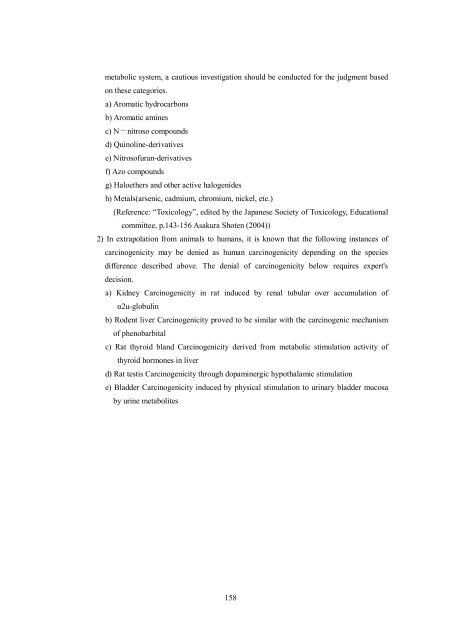GHS Classification Guidance for the Japanese Government
GHS Classification Guidance for the Japanese Government
GHS Classification Guidance for the Japanese Government
You also want an ePaper? Increase the reach of your titles
YUMPU automatically turns print PDFs into web optimized ePapers that Google loves.
metabolic system, a cautious investigation should be conducted <strong>for</strong> <strong>the</strong> judgment based<br />
on <strong>the</strong>se categories.<br />
a) Aromatic hydrocarbons<br />
b) Aromatic amines<br />
c) N-nitroso compounds<br />
d) Quinoline-derivatives<br />
e) Nitrosofuran-derivatives<br />
f) Azo compounds<br />
g) Haloe<strong>the</strong>rs and o<strong>the</strong>r active halogenides<br />
h) Metals(arsenic, cadmium, chromium, nickel, etc.)<br />
(Reference: “Toxicology”, edited by <strong>the</strong> <strong>Japanese</strong> Society of Toxicology, Educational<br />
committee, p.143-156 Asakura Shoten (2004))<br />
2) In extrapolation from animals to humans, it is known that <strong>the</strong> following instances of<br />
carcinogenicity may be denied as human carcinogenicity depending on <strong>the</strong> species<br />
difference described above. The denial of carcinogenicity below requires expert's<br />
decision.<br />
a) Kidney Carcinogenicity in rat induced by renal tubular over accumulation of<br />
α2u-globulin<br />
b) Rodent liver Carcinogenicity proved to be similar with <strong>the</strong> carcinogenic mechanism<br />
of phenobarbital<br />
c) Rat thyroid bland Carcinogenicity derived from metabolic stimulation activity of<br />
thyroid hormones in liver<br />
d) Rat testis Carcinogenicity through dopaminergic hypothalamic stimulation<br />
e) Bladder Carcinogenicity induced by physical stimulation to urinary bladder mucosa<br />
by urine metabolites<br />
158
















